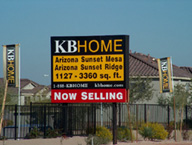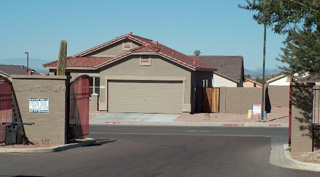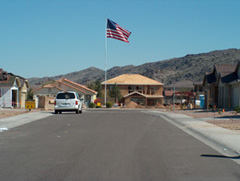 |
||
The New HoodOur group decided to dedicate a group project to a Residential Subdivision/Neighborhood Identity and Comparison. We choose two neighborhoods, one very new and one very old, that are built next to each other. Scott Nicholls describes the Old Hood and Ginni Colton compares the two neighborhoods. (Click on either of their names to see their websites or click on the neighborhood description to see their corresponding papers. Click on group to see a short video of us working together at Habitat for Humanity.)
After visiting the old south Phoenix neighborhood, we stared in disbelief at the stark difference between the two and named this subdivision “Clones & Drones.” This KB Homes subdivision is well maintained, very clean and tidy with signage informing the residents that the areas are to be kept in order. The subdivision’s epitome spaces are well kept, with a bleached look about them. Blake and Arreola (1996) describe epitome space as capturing the essence of the community identity and is a place for residents to gather. In this case, similar to the Rialto Hills and Echo Canyon areas Blake and Arreola studied, that neighborhood's epitome space also emphasizes recreation. The houses are single level, stucco, ranch-style homes with tile roofs. Immediately visible from the Dobbins Road turnoff are two large turf marker signs stating “No Trespassing, Violators Will Be Prosecuted”. The signs are in both English and Spanish. A large “Reward Sign” just beyond the open gates promises a sizable reward for assistance in apprehending and convicting individuals who cause damage, theft and/or destruction to the property. A large flagpole flying an American flag can clearly be seen from well beyond the fenced community. The Clones & Drones neighborhood
includes a Homeowners’ Association that charg Anticrime features for the subdivision include a large set of key coded gates and decorative metal and block fencing that surrounds the subdivision. On an individual basis, most occupied homes have small signs in their front yards, alerting the public of the alarm system protecting their home. Front yard enclosures include driveways, sidewalks and partial sitting-porches, close to the front door. All of these front yard areas are kept neat with minimal furnishings. House and yard ornamentation include awnings, stucco pop-outs, wrought iron fences, flagstone, lighting, ironwork yard art and decorative brick walkways.
|
||
| Holland Home Page | Contact Nikki.Holland@asu.edu | |
 The KB Homes subdivision at 10th Way
and Dobbins, built in January 2004, is a gated community with master
planned homes. The approximate mean value of the houses is approximate
$172,000 for 1800+ square feet. This subdivision holds approximately 70
to 80 homes.
The KB Homes subdivision at 10th Way
and Dobbins, built in January 2004, is a gated community with master
planned homes. The approximate mean value of the houses is approximate
$172,000 for 1800+ square feet. This subdivision holds approximately 70
to 80 homes.  es a $40 per month fee per
residence, to be used for front yard and common area maintenance and
upkeep. The main common area consists of an expansive park, which
includes picnic tables, basketball courts, a sand volleyball court, a full
sized soccer field and a large sandbox with children’s monkey bars and
swing sets. Even with these great amenities, on our visit, we did not
spot a single person in any of the common areas. David Guterson writes of
a similar experiences in his article No Place Like Home. He finds the
planned neighborhoods confusing in their sameness and eerily lacking
people (1992).
es a $40 per month fee per
residence, to be used for front yard and common area maintenance and
upkeep. The main common area consists of an expansive park, which
includes picnic tables, basketball courts, a sand volleyball court, a full
sized soccer field and a large sandbox with children’s monkey bars and
swing sets. Even with these great amenities, on our visit, we did not
spot a single person in any of the common areas. David Guterson writes of
a similar experiences in his article No Place Like Home. He finds the
planned neighborhoods confusing in their sameness and eerily lacking
people (1992). As we entered the subdivision we had
the good fortune to run into Tom, a resident of the subdivision who was
preparing to leave for work. He graciously answered our questions about
the subdivision and offered personal insight to the conversation. Along
with HOA facts, Tom also advised us that buyers who purchase-to-build make
many of the interior decorating choices and have the opportunity to choose
the exterior paint color and the type of entranceway built onto the
house. Since the landscape and front yard areas are maintained by the
subdivision, a resident cannot add anything to the landscape (ornamental
or foliage) without first obtaining the permission of the HOA. The HOA
does allow seasonal decorating. However, Tom added that he likes the HOA
and feels that the HOA fees are well spent. But he also provided that he
and his roommate have lived in the subdivision for only three months and
have never had any direct contact with the HOA.
As we entered the subdivision we had
the good fortune to run into Tom, a resident of the subdivision who was
preparing to leave for work. He graciously answered our questions about
the subdivision and offered personal insight to the conversation. Along
with HOA facts, Tom also advised us that buyers who purchase-to-build make
many of the interior decorating choices and have the opportunity to choose
the exterior paint color and the type of entranceway built onto the
house. Since the landscape and front yard areas are maintained by the
subdivision, a resident cannot add anything to the landscape (ornamental
or foliage) without first obtaining the permission of the HOA. The HOA
does allow seasonal decorating. However, Tom added that he likes the HOA
and feels that the HOA fees are well spent. But he also provided that he
and his roommate have lived in the subdivision for only three months and
have never had any direct contact with the HOA.